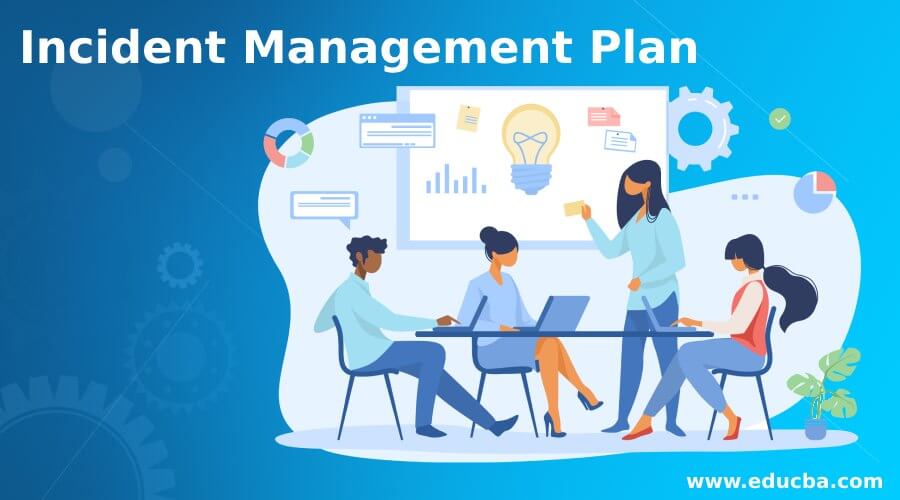Updated April 19, 2023

Introduction to Incident Management Plan
We have all heard the term incident management is often used. An incident management plan refers to the corrective actions taken by a company to prevent difficult situations. People are assigned to identify and analyze situations and prevent them from happening. During an event, the company takes risk management steps to stay on track.
An Incident management plan can come in quite handy at times of need. For example, you have launched a website for a company inviting people to book a particular product for a limited period of time. But the website crashes due to many people trying to book the product and the huge pressure on the website. In such a situation, you need to have an incident management plan and special teams devised for such situations so that the website can run at the earliest possible and with the least possible loss to the company.
Importance of IT Incident Management Plan
People often need to pay more attention to the need or importance of an incident management plan. Still, they are more important to the organization, especially IT firms, than they are given credit. It not only helps in the better management of resources but also helps in better customer satisfaction and ensures that people understand what the technology is all about. It does not need to be driven and is more customers oriented than thought. The company needs to understand that the incident management plan cannot follow the cut-copy-paste from the textbook method; instead, the company needs to understand the needs of the organization and the customer base it is serving and, in turn, customize the techniques accordingly.
There is a lot of documented incident management plan which is quite good; the tried and tested method of management, the ITIL books, the IT service management tool vendors, and the like provide a huge range of policies that the IT companies can adopt at the time of incident management plan. And there are a lot of entities that take the already defined course, the textbook course, but why not take the unconventional method? Why not make and follow your own incident management plan?
There are some easy steps that you have to follow in order to be able to formulate your own incident management plans or can even improvise the existing plan more suiting to your needs and organizational structure.
Steps to Formulate Incident Management Plan
The following are the steps that will help you to formulate the incident management plan:
-
Don’t just start following an incident management plan because it seems like a good plan
If you adopt an incident management plan just because you think it is right, you probably should hold that thought. Your incident management plan should focus more on needs and less on desires. In any case, the IT sector’s needs are more external than internal. IT firms often face problems related to their programs or customer-oriented issues rather than management discrepancies or machinery breakdowns.
Also, if the incident management plan is desire-driven instead of need-driven, then you won’t be able to provide the services as well as you expected. It is like you are going to a restaurant with amazing food and this amazing ambiance, but the service is not good enough. So you wouldn’t return to the restaurant no matter how great the food was. Hence, consider whether you are organizing it because you want to, it is the right thing to do, or because you need to take up an incident management plan because your organization needs it.
-
Realize the incident management plans that you are already following
Before taking up an incident management program, you need to evaluate the already incident management program going on in the organization. Most of the time, the IT company already has devised some of the plans, like password reset in case of any infiltration or the steps to be undertaken during hardware faults or system outages. Instead of simply discarding the existing incident management system and adopting a new one just because it’s listed in a fancy IT management book, you should try to understand the existing plan. It’s possible that the techniques currently in place are already effective. The play could better support the new technique you want to implement. The resultant technique may outperform the textbook and be more suitable for your organization.
-
Understand the real purpose behind the need for an incident management plan
You need to understand that you are taking up the task of the incident management process only because you think you need to fix the things that break when they break; then, I must insist that you think about it again. You need to understand that the incident management process aims to do more than just rectify the issue at hand. It is much more than that. You should understand the real purpose that the management technique solves. It is not about just fixing; it is more about supporting. The IT support professionals are not just supporting the IT but are also supporting the people in the IT firm.
-
Look at the service provided by incident management.
IT incident management plan is not just a process but a service. If you look at it as an incident management process, you will start an IT firm, as suggested by the textbook incident management process. You must understand that the IT incident management plan is much more than that. It is a means through which you can better your service-providing system, customer support system, and support service. Suppose you look beyond the incident management process and focus on the fact that it is a service. In that case, you will surprise at the number of activities and services the technique can provide and how you can improve your customer base and customer satisfaction and your employee satisfaction. And not only this, but you can also improve your services. The IT firm can handle problems with faulty websites or technology.
-
Watch our terminology
It is great that you want the people associated with your IT firm to know all about the incident management systems and everything to be crystal clear, but what is the fun of it if it does more harm than good? Before using the terminology, you first need to identify what kind of feeling or an event the people will associate with the word. For example, the word incident for non-IT people might not mean the same as it means to IT personnel. Simplify technical jargon to help non-IT professionals understand the problem.
-
Understand which side you are on, the supply side or the demand-side
You should first realize that the incident management process you adopt is for the consumer or the stakeholder. The focus should be on customer-oriented services, such as service level and business relationship management, rather than pleasing stakeholders. The company should customize IT services to serve the customer, making incident management and service desk hours demand-driven rather than supply-driven.
-
The incident management needs are not unique to your organization.
We are saying that you should not blindly follow it and should not be adopted because it seems like the right thing to do. Still, you also need to understand that the incident management system needs are not unique to any organization, i.e., all companies face the same problems more or less. Adapt important points from tested incident management methods and discard the rest. Focus on the outcomes of management techniques that can improve services rather than textbook methods. Adopt what suits your organization without adding too much bureaucracy or conflicting with existing rules and regulations.
-
Think of the people before the organization
The focus should be on prioritizing people over stakeholders. It is easy to sell a bad or even average technology if the people supporting it are good and efficient. It is a shame that a good or even a wonderful technology will be considered wasted if the people supporting it are not the best in their field. So basically, the incident management program is more people-oriented than product-oriented. It is more of how you deliver the IT services than what you deliver in IT services.
-
Look at the bigger picture of an incident management plan.
ITSM activities provide information from various sources like events, problems, configuration management, etc. It prepares you for future functions and fosters collaboration among people to better serve customers’ needs.
Of course, many things are beyond anybody’s control, but the incident management program ensures people are dedicated to meeting the target goals.
Incident management can go wrong if inconsistent with company regulations or too company-focused instead of customer-focused. It might result in the underutilization of resources and dissatisfaction among consumers. Still, there are a few things that the company needs to keep in mind. Then they can adopt the incident management plan that is best suited to them; they might even be able to customize the existing techniques and increase consumer satisfaction.
Recommended Articles
This is a useful guide to the incident management plan. Here we have discussed the basic concept, importance, and steps to formulate Incident Management Plan. You may look at the following articles to learn more –

